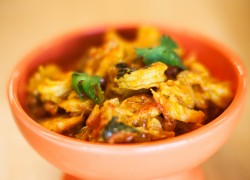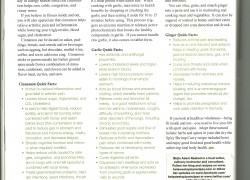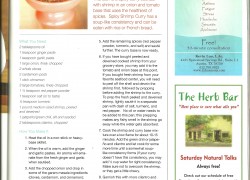This article below on the benefits of Spice for Health and Fitness written by Birjis Adeni Rashed was published in Austin Fit Magazine , November 2012 http://www.austinfitmagazine.com/November-2012/Spice-Up-Your-Health-and-Fitness/
You work out regularly, exercise is your life ritual, and fitness is your personality trait! Being a fitness enthusiast has made you more conscious of your body and health, and you realize that total body fitness and whole body health is about balance, inside and outside. Did you know that adding a little spice will keep your body and mind in healthy balance?
Fitness routines magnify your awareness of body, health, and lifestyle. You start to realize how your body responds to your way of life as a whole, be it overeating, stress from work, lack of sleep, exertion from strenuous exercise, inflammation or stiffness in bones and muscles, pain from physical injuries, fatigue and low energy, or even factors such as allergies from environmental exposure that can affect the very course of your life. Once you realize these effects, you can make positive changes and spice up to promote overall health. Nature is a true healer and certain spices and herbs will naturally prevent certain illnesses, fight infections, cure and cleanse your system with their antiseptic, antibiotic, anti-inflammatory, and antioxidant properties when part of your diet.
With this in mind, let’s examine how you can add big flavor as well as gain health benefits by adding common Indian cooking spices such as cayenne, turmeric, cinnamon, ginger, and garlic into your daily menu.
Cayenne Pepper
Cayenne peppers (also known as red chili peppers) are often linked with hot and spicy food. These strong flavored peppers have a lot of therapeutic cures—inside and out, and body and mind.
Next time you bite into a red chili pepper or eat spicy food, notice the increase in your body temperature. This rise in body temperature actually accelerates your metabolism, increases blood circulation, clears out fat and triglycerides, and enhances your cardiovascular performance while lowering blood pressure.
The capsaicin in peppers also helps release feel-good endorphins and boosts stamina and vigor in conjunction with reducing aches and pains, alleviating inflammation, and reducing the pain of arthritis.
Cayenne can be added to any recipe during cooking or when marinating with salt and pepper to gain from its healing benefits. Cayenne or red chili powder dusted on a dark chocolate bar is known to be an aphrodisiac, too.
Cayenne Quick Facts:
- Is known for being a systemic stimulant. Increases blood circulation, clears arteries of fat and triglycerides, and enhances cardiovascular performance while actually lowering blood pressure.
- Has an energizing effect on the body. Helps overcome fatigue and restore stamina and vigor.
- Regulates glucose and insulin levels.
- Boosts metabolism.
- Acts as a diuretic and helps in
weight loss. - Acts as an antiseptic in curing gastrointestinal and stomach infections.
- Is used to relieve aches and soreness.
- Helps fight prostate cancer and ulcers.
- Alleviates inflammation and reduces pain of arthritis. When externally applied, causes temporary pain on the skin but offers relief for joint pain.
- Releases endorphins, creates a state of well-being. Acts as a powerful stimulant and wards off depression caused by physical and emotional trauma.
- Has diaphoretic properties, causing you to sweat, causing it to be used in detoxification. Helps in total body detox when consumed in the morning as tea made with cayenne, lemon juice, and honey.
Turmeric
Turmeric is nature’s wonder spice. It’s not just a condiment and coloring agent but a medicine as well. Turmeric is known for its many therapeutic cures (anti-inflammatory, antibiotic, anti-oxidant, and hypoglycemic) and antiseptic properties.
Let’s say you are suffering from an inflamed knee joint. Adding a little turmeric to your stew or soup will help reduce inflammation, pain, swelling in external and internal injuries, and increase your rate of healing. As an added benefit, turmeric helps cure damage to muscles, bones, ligaments, and tendons after strenuous exercise.
Turmeric can be added in moderation to any recipe, during cooking or while marinating, to gain from its healing benefits. If high protein food is part of your diet, turmeric can aid in digestion of protein, promote metabolism in the body, and act as carminative (expels gas) and stomachic (tonic for belly ache) in the treatment of digestive disorders.
Turmeric is also widely known for its decongestant and expectorant properties. Drinking warm milk with one-half teaspoon of turmeric is good for curing colds, coughs, and other bronchial ailments, especially during allergy seasons. Turmeric capsules are also available in the pharmacies if you find it difficult to adopt this spice in your cooking.
Turmeric Quick Facts:
- Helps reduce arthritis and stiffness of bones.
- Protects the liver from toxins and cholesterol. Lowers blood sugars and blood cholesterol.
- Promotes proper metabolism in the body, correcting both excesses and deficiencies. Aids in protein digestion. Helps remove adipose tissue and cuts cellulite from the body. Cleans toxins, eliminates water retention, tones the body, and helps in reducing body weight!
- Purifies, stimulates, and builds blood and is therefore beneficial for blood disorders and anemia.
- Used as a carminative and stomachic in the treatment of digestive disorders such as flatulence, bloating, diarrhea caused by eating a lot of high-fiber foods, high protein, and health foods.
- May prevent metastases from occurring in many different forms of cancer (is being evaluated for its anti-carcinogenic properties).
- Reduces plaque deposits in brain, hence reducing progression of Alzheimer’s.
- Acts as an expectorant and decongestant for irritating coughs, colds, bronchitis, asthma, and tuberculosis.
- Helps stop bleeding and acts as an antiseptic when applied externally to bruises and cuts.
Cinnamon
This sweet tasting, aromatic spice has a lot of utilitarian benefits besides flavor. Cinnamon is said to contain some antibacterial, antifungal, antioxidant, and astringent properties. It’s also a good source of manganese, fiber, iron, and calcium.
Did you ever ponder why a cup of coffee or tea with cinnamon perks you up? Well, cinnamon is believed to improve energy, vitality, and circulation as well as decrease fatigue. Simply smelling cinnamon is said to boost cognitive function and memory. Eating cinnamon and local honey on an empty stomach is the best way to start your day in allergy season since this combination helps cure colds, congestion, and runny noses.
If you believe in fitness inside and out, you will also appreciate that cinnamon helps relieve arthritic pain and inflammation while lowering your triglycerides, blood sugar, and cholesterol.
Cinnamon can be dusted on cakes, puddings, breads, and cereals and on beverages such as eggnog, hot chocolate, mulled wine, coffee, and tea to add extra zing. Cinnamon sticks or garam masala (an Indian ground spice made from a combination of cinnamon, cardamom, and cloves) can be added to flavor meat, curries, and stew.
Cinnamon Quick Facts:
- Known to reduce inflammation and give relief in arthritic pain.
- Lowers blood sugar, triglycerides, and LDL cholesterol.
- Is said to help digest foods, reduce acidity, and aid in fat burning when combined with honey and eaten before food (this combination is also said to reduce gas in stomach and flatulence and improve energy, vitality, circulation, and decrease fatigue).
- Boosts cognitive function and memory when regularly smelled.
- Helps reduce colds caused by allergies, congestion, and bronchial infection in lungs with one half spoonful is combined with local honey.
- Treats gastrointestinal problems, bladder infections, yeast infections, thrush and even stomach ulcers with its antibacterial and antifungal properties.
Garlic
A popular ingredient in Indian, Italian, and French cuisines, garlic has been known for its medicinal purposes for many centuries. It has antibiotic, antifungal, antimicrobial, hypotensive, anticatarrhal (dissolving and eliminating mucous), expectorant, stimulative, and vulnerary (useful in the treatment of wounds) properties.
While garlic may leave you with bad breath, it’s working hard to lower your blood pressure, triglycerides, and cholesterol. Its volatile oils are an effective agent against colds and bronchial ailments and on viral and bacterial parasites.
Garlic can be eaten in many forms but it’s most potent when eaten raw. When cooking with garlic, maximize its health benefits by chopping or crushing the garlic and then setting it aside for 10 to 15 minutes before using. This process triggers an enzyme reaction or releases active phytochemicals that boosts the healthy compounds in garlic. If you cannot handle raw garlic, it also comes in tablet form.
Garlic Quick Facts:
- Has antibiotic and antifungal
properties. - Lowers cholesterol levels and triglyceride levels in blood.
- Lowers high blood pressure when eaten in mornings on an empty stomach.
- Acts as blood thinner and prevents clotting, which benefits heart patients.
- Relieves colds and bronchial ailments. Is a good medicine in syrup form for asthma, hoarseness, coughs, difficulty of breathing, and most other disorders of the lungs, including chronic bronchitis).
- Stimulates good supply and flow of breast milk in lactating mothers.
- Reduces arthritic and rheumatism pain when combined with honey.
- Reduces risk of developing several types of cancer.
- Cures digestive ailments.
- Disperses hard swellings and acts as an antiseptic when juice expressed from crushing garlic is applied externally to wounds.
- Soothes ear aches when heated olive oil with garlic is strained, cooled, and placed in the ear with cotton balls.
- Cures hysteria when crushed and sniffed.
Ginger
Ginger root is a spicy herb with many antioxidant, anti-inflammatory, anti-viral, carminative, and rubefacient (increasing blood flow to the skin) properties. By adding fresh chopped or crushed ginger in your cooking, you are putting natural digestive tonics into your food.
A great cure for cramps is to drink a ginger decoction (boil a spoonful of chopped ginger in water). Ginger has rubefacient properties and as such helps in arthritis pain, inflammations, swelling, and fibrositis.
You can slice, grate, and smash ginger into a paste and use it in marinating and cooking meat and vegetables. It can also be sugared or soaked in honey and then eaten or dropped into a tea decoction and drunk.
Ginger Quick Facts:
- Reduces arthritis pain and swelling.
- Acts as an anti-flatulent and antacid. Helps in treating upset stomachs, gastrointestinal disorders, gas, and bloating.
- Cures sore throats and colds when combined with honey.
- Decreases motion sickness and nausea.
- Helps in reducing menstrual cramps, bloating, and is an emmenagogue (agent that promotes menstrual discharge), too.
- Helps to promote perspiration and cure water retention in the body.
If you look at health as wholeness—being fit inside and out—you need to live your life with sport and spice. Adopt these natural holistic herbs and spices in your diet (try the Spicy Shrimp Curry recipe included here) and enjoy good food and good health while achieving total body health.
Spicy Shrimp Curry Recipe
This dish is a spicy curry cooked with shrimp in an onion and tomato base that uses the healthiest of spices. Spicy Shrimp Curry has a soup-like consistency and can be eaten with rice or French bread.
What You Need
2 tablespoons oil
1 teaspoon ginger paste
1 teaspoon garlic paste
1 large onion, finely chopped
2 whole cloves
2 cardamom pods
1 stick cinnamon
3 large tomatoes, finely chopped
1 ½ teaspoon red pepper powder
1 teaspoon salt (or to taste)
½ teaspoon turmeric
1 pound medium-sized shrimp, peeled
and deveined
1 jalapeño/green chili, slit and seeded
2 tablespoons cilantro, chopped
How You Make It
- Heat the oil in a non-stick or heavy-base skillet.
- When the oil is warm, add the ginger and garlic pastes. An aroma will emanate from the fresh ginger and garlic when sautéed.
- Add the chopped onion and drop in some of the garam masala ingredients (cloves, cardamom, and cinnamon); these, too, emanate a pleasant aroma.
- When the onion starts to get translucent, add the tomatoes. Sauté the mixture over a low flame for some time.
- Add the remaining spices (red pepper powder, turmeric, and salt) and sauté further. The curry base is now ready.
- If you have bought peeled and deveined cooked shrimp from your grocery store, you may add it to the tomato and onion base at this point. If you bought fresh shrimp from your favorite seafood center, you will need to peel off the shell and devein the shrimp first, followed by prepping before adding the shrimp to the curry. To prep the fresh peeled and deveined shrimp, lightly sauté it in a separate pan with dash of salt, turmeric, and red pepper. No oil or water needs to be added to this pan; this prepping makes any fishy smell in the shrimp go away while the water gets absorbed.
- Cook the shrimp and curry base mixture over a low flame for about 10-15 minutes. Add the green chili or jalapeño and cilantro and let cook for some more time until a somewhat soup-like consistency forms (if your curry doesn’t have this consistency, you may add ½ cup water for right consistency). Make sure not to overcook the shrimp, or they get a little chewy.
- Garnish this with more cilantro and serve with your choice of jasmine-flavored white rice, basmati rice, or fresh French bread.
Birjis Adeni Rashed is a food writer, culinary instructor and consultant. Follow her blog and recipes on www.hotsweetspicyrecipes.com or follow her updates on www.facebook.com/hotsweetspicyrecipes or www.twitter.com/HtSwtSpcyRecipe
Click on this gallery of pictures to see the Magazine Article 😉









